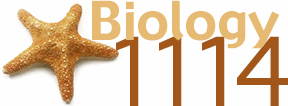
For a printable copy of this page click here.

Scenario: Local and national headlines related to industrial-scale livestock and poultry farming introduce biological concepts such as eutrophication, biogeochemical and nutrient cycling, community and ecosystem ecology, and biological diversity human impacts.
|
Icon
Key:
|
|
|
|
|
|
Examples of In-Class Discussion and Thought Questions:
Thought Questions/Homework:
Related Laboratory Experiments and Tutorials:
Lab 12: How does sewage affect benthic and algal species
diversity in streams?
Corresponding Essential Study Partner Segments:
| The Essential
Study Partner is part of the McGraw-Hill Web Site. To access it go here. Then follow these relevant paths below: |
Many of these are figures and accompanying text, but some are video clips that should help you see the process in action.
The site for your textbook Life by Ricki Lewis
|
Focus: Livestock Legacy An article containing a discussion of the livestock industry with respect to lagoon spills, chronic seepage and runoff, airborne health effects, waste regulation, and solutions to management problems |
|
|
Biological Stream Assessment This site is designed to help you develop general information about the quality of freshwater streams and rivers |
|
|
GREEN (Global Rivers Environmental Education Network) Contains a list of watershed education resources on the internet |
|
|
Beneficial Use of Bio-Solids (Sewage Sludge/Septage/Animal Manure) Contains many links concerning the beneficial uses of bio-solids |
|
|
Fact-Finding Tour House Republicans Plan Fact-Finding Tour Of Agricultural Sites in N.E., S.W. Okla. |
|
|
The World-Wide Web Virtual Library: Earth Sciences Resources Earth Sciences Resources, lots of helpful links |
|
|
Water Pollution discusses 3 types of water contaminants |
|
| How sewage is regulated in the U.S. and the State of Washington discusses federal, state, and local governmental responsibilities in sewage regulation | |
|
Microbial Menaces article on microbial conatimination of water sources |
|
| Sewage Problems Alternatives to traditional Sewage treatment facilities | |
 source |
Toxic and Harmful Algal Bloom goes into more depth about "Red Tides" |
The website for your textbook has flashcards organised by chapters. You are only responsible for topics discussed in class. For this scenario, flashcards with the Major Terms Introduced can be found in:
Chapter 1: What is Life?
Chapter 21: Protista
Chapter 24: Animalia I--Sponges Through Echinoderms
Chapter 42: Populations
Chapter 43: Communities and Ecosystems
Chapter 44: Biomes and Aquatic Ecosystems
Chapter 45: Environmental Challenges
- Meadows, R. 1995. Livestock Legacy. EHP monthly journal:103(12).
- Coral bleaching
- National Oceanographic and Atmospheric Admin.; Press release 1998- House Republicans Plan Fact-Finding Tour Of Agricultural Sites in N.E., S.W. Okla.12/16/97.